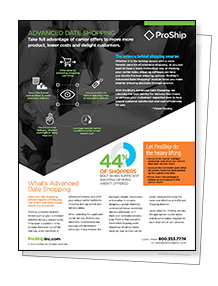If you don’t begin to implement these offerings and provide gold-level service, your competitors will.
Nowadays, shopping is much more than the simple act of just grabbing items off shelves and clothes off the racks. It is about convenience. Consumers want the option to be in the comfort of their own home ordering items from a website or even on an app on their phone. They also want the items delivered exactly when they expect them, which – while unrealistically – can be as soon as they click “confirm order.” To meet these exceedingly high expectations, retailers are constantly exploring innovative ways to get orders to customers as soon as possible. In fact, many are placing a greater priority on streamlining the order fulfillment process than price or product.
This is the result of retailers understanding that the key to consumers’ hearts is on-time delivery. By fulfilling delivery time promises, retailers create a positive and memorable experience that keeps their customers coming back. But on-time delivery is easier said than done. Anticipating external factors that can impact delivery times isn’t for the faint of heart. Retailers must have the foresight to account for these factors in order to offer a superior customer experience.
To do this, retailers are reevaluating their carrier mix and adding rate shopping into their shipping process. Not only does this save both time and money for themselves and their customers, it can also position the company for success.
But many are left wondering where to begin.
Optimize Delivery
The first step is for each retailer to determine their own customers’ unique needs. While Amazon’s customers want two-day or even same-day delivery, other retail customers may have more lax expectations, such as preferring free three-day or ground shipping. Understanding these specific delivery demands allows retailers to avoid the added costs of offering complimentary two-day delivery services, especially when their customers don’t necessarily require it.
Once customers’ shipping services expectations are clear, it is time to develop relationships with a variety of shipping partners.Retailers can utilize local, regional, and national carriers to create their own unique shipping carrier network to get the best shipping rates and times. While national carriers cover a much larger area and offer a variety of services, local and regional carriers provide competitive pricing and faster delivery times along with wider time schedules for pick-up. These carriers also provide great alternative options, especially during peak shipping season when some of the national carriers’ lanes are overloaded or unavailable. By having a variety of shipping partners, retailers will be prepared for anything that comes their way.
With a clear carrier mix in place, it can take time to evaluate which carrier is the best for each and every package. This is where automated rate shopping comes in. This shipping software feature allows retailers to choose the most effective and time efficient method of transit to get each package onto the truck and out to customers fast.
There are three types of rate shopping options that can help boost business:
Basic Rate Shopping
This is the simplest option, as it allows behind-the-scenes service that automatically provides the lowest cost shipping options. This rate shopping feature considers the total cost of shipping and applicable service selections, which look at different secondary factors, including rate shop groups, cost normalization, service validation by destination, and service validation by package attributes. By reviewing many different parts of the delivery, retailers can get the full picture on the rate of each parcel. This ensures there are no mistakes, such as handing a package to an LTL service when a small parcel service could handle the delivery much faster and at a lower cost.
Time in Transit Rate Shopping
This type of rate shopping takes it to the next level by sorting the rate shopping list and filtering it by the number of business days the package would be in transit. This is especially important for retailers with customers that demand fast delivery services.
Advanced Date Shopping
Often referred to as the king of rate shopping, this system plans delivery by a specific target date. It uses nine data sets – such as the customer’s day/hour of choice, label creation time, trailer pull time, and carrier contracted days – to maximize the ability for each package to be delivered on the promised date. This type of rate shopping results in money saved by selecting the best carrier for every package dependent on the customer’s location and desired delivery date. It ensures customers receive their orders when they expect them, and not a minute later.
With 66% of US retail shoppers indicating that they consider fast delivery to be the most influential factor in cart abandonment, according to a survey from customer-feedback platform Usabilla, retailers must automate their shipping processes to meet consumer demands. The same survey also found that 58% of shoppers abandon carts because of high shipping costs. This shows just how much customers are expecting inexpensive, or even free shipping, and for their orders to be delivered fast. If you don’t begin to implement these offerings and provide gold-level service, your competitors will.
Justin Cramer is Head of Sales & Marketing and Co-Founder at ProShip, Inc, the global provider of today’s #1 multi-carrier shipping software. Throughout his time at ProShip, Cramer has designed shipping solutions responsible for executing more than 1.1 million labels per day and has worked with many small to global shippers on achieving certified carrier labels. For more information, please visit their website at www.proshipinc.com or see Justin at the PARCEL Forum on October 30, 2019 as he discusses this topic in-depth. View the original publication of this article on PARCEL.

 Back to Blog
Back to Blog







